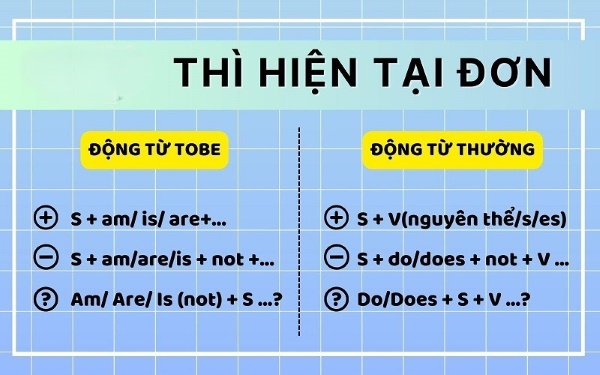Tổng hợp bài tập thì hiện tại đơn có đáp án giúp bạn luyện ngữ pháp
Views: 1
Thì hiện tại đơn là nền tảng quan trọng trong tiếng Anh, dùng để nói về thói quen, sự thật và hành động diễn ra thường xuyên. Để nắm vững thì này, việc luyện tập qua các bài tập thực hành là vô cùng cần thiết. Bài viết dưới đây tổng hợp các bài tập thì hiện tại đơn đa dạng, có đáp án chi tiết giúp bạn dễ dàng học và áp dụng hiệu quả vào giao tiếp hằng ngày.
1. Bài tập chia động từ ở thì hiện tại đơn
Bài tập 1: Chia động từ trong ngoặc sao cho đúng
-
She (go) to school every day.
-
They (not like) watching horror movies.
-
My father (work) in a hospital.
-
What time your class (start)?
-
I (play) the guitar after dinner.
-
He (study) English on weekends.
-
The train (leave) at 8 o’clock.
-
My friends (visit) me every summer.
-
We (not eat) breakfast at home.
-
She always (drink) coffee in the morning.

Đáp án:
-
goes
-
don’t like
-
works
-
does … start
-
play
-
studies
-
leaves
-
visit
-
don’t eat
-
drinks
2. Bài tập viết lại câu với thì hiện tại đơn
Bài tập: Viết lại các câu sau sao cho cùng nghĩa hoặc diễn đạt lại tự nhiên bằng thì hiện tại đơn.
-
He gets up early every day → Every day, he ________ early.
-
My sister always eats breakfast at 7 a.m → Breakfast ________ by my sister at 7 a.m.
-
They don’t play soccer after school → After school, they ________.
-
The shop closes at 9 p.m → 9 p.m is the time the shop ________.
-
I usually go to bed at ten → I ________ at ten o’clock most nights.
-
She studies math every morning → Every morning, she ________ math.
-
Tom watches TV before dinner → Before dinner, Tom ________ TV.
-
We don’t go out on weekdays → On weekdays, we ________ home.
-
My parents visit my grandparents every Sunday → Every Sunday, my parents ________ my grandparents.
-
Jane often walks to school → She usually ________ to school instead of taking a bus.

Đáp án gợi ý:
-
gets up
-
is eaten
-
don’t play soccer
-
closes
-
go to bed
-
studies
-
watches
-
stay
-
visit
-
walks
3. Bài tập đặt câu hỏi với từ cho sẵn
Bài tập: Đặt câu hỏi ở thì hiện tại đơn dựa vào gợi ý.
-
(Where / your brother / work?)
-
(What time / she / get up?)
-
(Who / teach / you / English?)
-
(How / they / go / to school?)
-
(Why / you / like / coffee?)
-
(What / your friends / do / on weekends?)
-
(When / your family / have / dinner?)
-
(Which / subject / you / like / best?)
-
(How often / she / go / swimming?)
-
(Where / the train / stop?)
Đáp án:
-
Where does your brother work?
-
What time does she get up?
-
Who teaches you English?
-
How do they go to school?
-
Why do you like coffee?
-
What do your friends do on weekends?
-
When does your family have dinner?
-
Which subject do you like best?
-
How often does she go swimming?
-
Where does the train stop?
4. Bài tập chọn đáp án đúng
Bài tập: Chọn đáp án đúng để hoàn thành câu.
-
My mother ________ in a bank.
A. work B. working C. works D. to work -
The sun ________ in the east.
A. rise B. rises C. rising D. to rise -
They ________ like vegetables.
A. doesn’t B. don’t C. not D. didn’t -
What time ________ your class start?
A. do B. is C. does D. are -
The shop ________ at 7 a.m every day.
A. opens B. open C. opening D. to open -
We ________ our homework every night.
A. does B. doing C. do D. to do -
It ________ very often in this area.
A. rain B. rains C. raining D. to rain -
She ________ coffee in the morning.
A. drink B. drinking C. drinks D. to drink -
________ he like to read books?
A. Is B. Do C. Does D. Has -
They ________ football after school.
A. plays B. playing C. play D. to play
Đáp án:
-
C 2. B 3. B 4. C 5. A 6. C 7. B 8. C 9. C 10. C
Tham khảo thêm: sau is là gì
5. Bài tập hoàn thành đoạn văn với thì hiện tại đơn
Bài tập: Điền dạng đúng của động từ trong ngoặc để hoàn thành đoạn văn.
Đoạn 1:
Anna (live) in a small town. She (go) to school by bus every morning. Her best friend (sit) next to her on the bus. They usually (talk) about homework or (listen) to music together. Anna (enjoy) her school life very much.
Đáp án:
lives, goes, sits, talk, listen, enjoys

Đoạn 2:
My family (have) breakfast together at 7 o’clock. My father (read) the newspaper while my mother (cook) eggs and bread. I (help) her set the table and my brother (pour) milk into glasses. After breakfast, everyone (leave) the house at 7:45.
Đáp án:
has, reads, cooks, help, pours, leaves
6. Bài tập viết câu phủ định và nghi vấn
Bài tập: Viết lại các câu sau ở dạng phủ định và nghi vấn.
-
She likes chocolate.
-
They study English every day.
-
He plays basketball after school.
-
We live in Ho Chi Minh City.
-
The dog barks at night.
-
My father drives to work every morning.
-
They eat dinner at 6 p.m.
-
She works in an office.
-
The children go to bed at 9 o’clock.
-
He cleans his room on Sundays.
Đáp án:
-
She doesn’t like chocolate. / Does she like chocolate?
-
They don’t study English every day. / Do they study English every day?
-
He doesn’t play basketball after school. / Does he play basketball after school?
-
We don’t live in Ho Chi Minh City. / Do we live in Ho Chi Minh City?
-
The dog doesn’t bark at night. / Does the dog bark at night?
-
My father doesn’t drive to work every morning. / Does your father drive to work every morning?
-
They don’t eat dinner at 6 p.m. / Do they eat dinner at 6 p.m.?
-
She doesn’t work in an office. / Does she work in an office?
-
The children don’t go to bed at 9 o’clock. / Do the children go to bed at 9 o’clock?
-
He doesn’t clean his room on Sundays. / Does he clean his room on Sundays?
Tham khảo thêm: vstep speaking part 2
Kết luận
Những bài tập thì hiện tại đơn trên đây sẽ giúp bạn củng cố kiến thức ngữ pháp, ghi nhớ công thức nhanh và áp dụng chính xác trong giao tiếp hằng ngày. Hãy luyện tập thường xuyên để phản xạ tự nhiên hơn khi nói và viết tiếng Anh. Nếu bạn muốn học thêm ngữ pháp TOEIC hoặc các dạng bài luyện chuyên sâu, hãy truy cập ngay anhnguthienan.edu.vn để khám phá nhiều tài liệu hữu ích.





